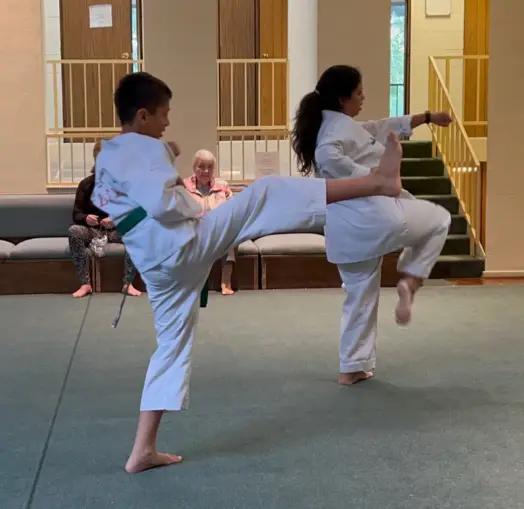Dx Ataxic Cerebral Palsy: Abigail’s Success Story
“There is nothing more you can do”
Abigail’s Mother is not buying it
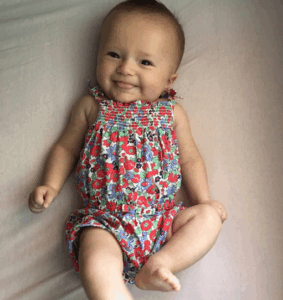
Abigail was born at 41 weeks and 1 day at 7lbs 9 oz with a head full of dark hair and coffee bean eyes. She was breathing at birth and scored high on her newborn screenings. We were over the moon to finally be holding the child we had been waiting for, not knowing that our lives would look nothing like how we imagined. We first noticed a delay in milestones at six months old. Abigail was able to roll over from her tummy to her back but was unable to sit without support. By twelve months, Abigail was finally able to sit without support and began to crawl in a homolateral pattern.
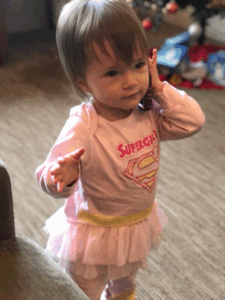
At 18 months she began to walk and simultaneously lost the speech that she had. Our pediatrician didn’t seem concerned because even though all her milestones were delayed, she still eventually accomplished them. We disagreed with the pediatrician and sought Occupational Therapy and Speech Therapy for Abigail. Abigail was diagnosed with apraxia of speech, sensory processing disorder, and fine and gross motor delays. At age 2 we recognized she didn’t have any depth perception and was falling frequently. We sought the help of a developmental optometrist who recognized that in addition to not having depth perception or peripheral vision, she had convergence insufficiency, and her eyes weren’t tracking properly. She was prescribed prism glasses to help her depth perception.
At age 2 Abigail transitioned to a Montessori school in a toddler classroom. I was hopeful the transition would be easy as my primary classroom was next door, and we would be going to school together. Her teachers struggled to understand her limited language, so we focused on teaching her sign language to meet her basic needs. Abigail remained in speech therapy and occupational therapy to support her speech, fine and gross motor delays, and sensory craving. When she transitioned into my classroom the environment was a challenge as she often mouthed objects, had limited language, and was frustrated with social interactions. Over the next three years the gap in her learning seemed to increase each year and we delayed her start into public school until age 6.5.
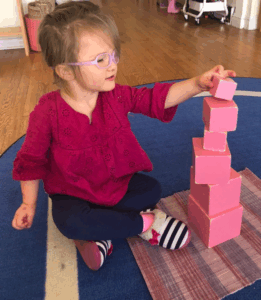
Transitioning to public school was a battle ground. Within the first two weeks I found myself walking into that school nearly every day pushing for more understanding, accommodations, and support. It took an entire year to get her Individual Education Plan in place and even then, the support was not enough, and the gap was getting bigger with each passing day. The professionals were baffled at her presentation and couldn’t figure out why the supports they had put into place weren’t working. Kindergarten left us all feeling defeated and I was watching my child wilt right in front of me. In 1st Grade we shifted our priorities to Abigail’s emotional well-being and the sense of community she felt at school. She had an incredible teacher who always included her and even though the academics were challenging, she was able to shine bright with the right adults seeing her. We found our helpers amongst the battle ground of a system that wasn’t meant for her.
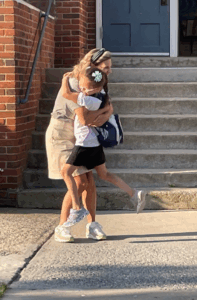
On an ordinary day, Abigail’s occupational therapist had brought in a neuro trained occupational therapist to fill in for her. The next day I got a call that the neuro trained OT was suspecting that Abigail had Ataxic Cerebral Palsy. When I first heard those words, I was in disbelief. My child could walk, talk, and she looked like every other child in a crowded room. However, her challenges aligned with the diagnosis and had the potential to solve the mystery we had been trying to solve for her entire life. Less than a month later Abigail was formally diagnosed with Ataxic Cerebral Palsy, and I took a big sigh of relief. We finally had an answer and now I could find a clear path to move forward. We followed our OT’s recommendation for imaging with a physiatrist. In the meantime, I called my dear friend shortly after and she told me she would do some research and get back to me with some ideas of how to move forward.
My friend came back with the “What To Do About Your Brain Injured Child” book and told me that the person that recommended it to her said “start reading it and get past the title”. Just a couple pages into the book I put it down and emailed The Institutes. I had been shown the path. Shortly after her diagnosis, a brain MRI further confirmed the extent of her brain injury. We were told it was mild and it “wasn’t that bad in the grand scheme of Cerebral Palsy”. The physiatrist looked at me and said, “There’s nothing more we can do. You’ve maxed out therapy options.” I smiled at Abigail and caught his gaze before he walked away. “Watch me”, I replied. I had her records transferred on our way out and less than six weeks later we were at The Institutes after I had completed the What To Do About Your Brain-injured Child course. The physiatrist that diagnosed her was right. There was nothing more he could do. But I had just gotten started.
The What To Do Course dismantled everything I had ever been taught about the challenges my child was facing and how I had been trained as an educator to understand learning disabilities, speech delays, and autism. We had been going down a one-way street the wrong way the entire time. Before the course even started, I was committed to the program. We had tried everything with minimal results, and we had nothing to lose. That week I realized that we would have to radically change our lives for Abigail’s health. We tossed everything in our pantry that wasn’t on the nutrition program, transitioned our basement into a space for her patterning table, brachiation ladder, and a track for creeping and crawling. We medically withdrew her from public school. We haven’t looked back.
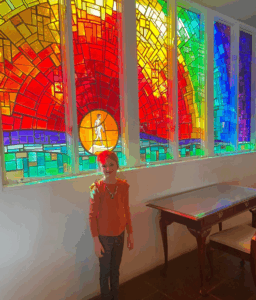
My advice to any parent of a child with a brain injury is to follow the roadmap that The Institutes have spent 70 years perfecting. Read the book, take the What To Do About Your Brain Injured Child course, and most importantly get your child to Philadelphia. Find a way to get to Philadelphia, because every barrier that you overcome and every small miracle that it takes to get to The Institutes is worth it. The potential to change the life of your child and your family is right in front of you. You will be met at the door with open hearts, open arms, and most importantly, a sense of belonging that you or your child have likely not felt anywhere else in the world. There isn’t anywhere else in the world that sees your child and their potential in the way that the Staff of The Institutes do. Believe me, I’ve searched the world over and haven’t found it anywhere else.
In one of Abigail’s educational documents, I was given the opportunity to write a parent statement about our vision for Abigail. Mind you, my child had just been “labeled” with multiple disabilities and had the most comprehensive Individual Education Plan in our county school district. Our vision for Abigail is that she will confidently march through life to the beat of her own drum because she is anything but ordinary; she is extraordinary. I believed that statement with my whole heart then and I believe it even more so now. Abigail was going to march to the beat of her own drum anyway regardless of our decision to follow the work of The Institutes, but at some point, I fully expected her confidence to drop because of the world we live in. However, The Institutes have given her this confidence that has been invaluable to her success. I think of that vision statement often during the long days of Abigail’s program because I’m no longer the only person that believes that she is capable of so much more than what other professionals wanted us to believe.

Our work at The Institutes started by working on healing her gut. After an overuse of antibiotics as a toddler for chronic ear infections, Abigail had developed a candida overgrowth that needed to be addressed, and we eliminated all fruits for 9 months. Once the overgrowth was controlled by diet change and appropriate supplementation, Abigail began gaining weight. In the first four months on her home program, she gained 7 pounds, and we saw a growth in height, chest, and head measurements. This weight gain was more than she had collectively gained in the prior three years of her life. We started her oxygen enrichment program immediately after our visit to The Institutes and within the first week of masking she was sleeping through the night. We quickly noticed a change in her mood, behavior, and overall regulation with the nutrition and oxygen enrichment program. Her hyperactivity had decreased significantly within two weeks of starting her nutrition program.
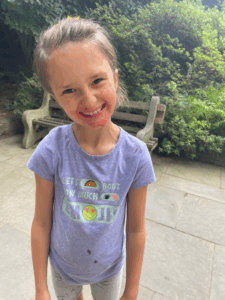
We started our home program with patterning, creeping, crawling, and hanging. Because Abigail was already 8 years old, we decided to include her in the decisions around her program. She picked out the tiles for her track, the color of her patterning table, and helped us invite people to come to our home each morning at 7 am to pattern. We believe that the success of her program has been largely in part to her own participation in the program. She is proud of her program and enjoys the interactions with our army of patterners each morning. Abigail can now independently brachiate across her brachiation ladder and can run a 12-minute mile. Her core, which was once hypotonic, is now strong as she is gaining balance and coordination. Her lazy eye went straight within 8 weeks of starting her program. Her language has become clearer, her handwriting is more legible, and she received a writing victory four months after starting her home program.
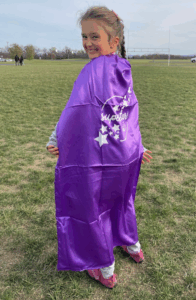
Abigail enjoys her intellectual program and is eager to read new words, couplets, sentences, and homemade books. She enjoys a wide variety of categories through her Bits of Intelligence cards and is eager to share what she is learning with others. Reading was always a challenge for Abigail, and we saw her confidence in reading continue to decrease overtime in public school. It has been a breath of fresh air to see her excited about reading and gaining new knowledge. She is now reading signs when we are out and about and has a new confidence with her intellectual abilities. Her curiosity is flourishing as she creates new connections within her world and now has the skills to express them. Her recall and memory are increasing daily and for the first time in her life, she is recalling song lyrics and singing them to us.
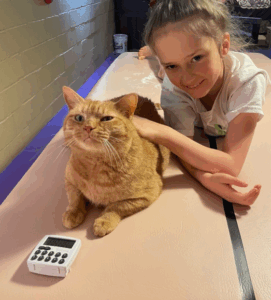
There isn’t a way to adequately express just how different (and better) our lives are since finding The Institutes and starting her home program less than a year ago. Abigail is the healthiest she’s ever been. She is sleeping through the night and wakes up rested. She has the energy to accomplish her rigorous physical program. She’s no longer falling because of poor balance and coordination. She can express herself and feels proud of the work she does each day. She recently ran a 5k in 41 minutes and as she crossed the finish line, she declared that she wanted to sign up for another race. The most surreal parts of this experience have been the situations that were once difficult are now seemingly easy. Events like dental cleanings used to be dysregulating and now she’s able to sit through them effortlessly. She is composed when walking into a store and can help contribute to our daily life. We’re finally seeing the true Abigail.
A year ago, before taking the What To Do Course, I worried a lot about what her future would look like and if we would have a child that would one day be a fully independent adult. The difference now is that we have an army of people at The Institutes that believe she is extraordinary, and the program is organizing her brain in ways we could have only dreamed of. We’re watching her change and grow physically and neurologically every day. Just in the first four months of her program, Abigail neurologically grew 12 months. The growth and results she experienced those first four months of her home program are more than the 6 years of traditional therapy she endured. Her home program has been one of the most physically and mentally exhausting experiences we’ve ever navigated as a family, and we will do it every day, until Abigail is well and she graduates to life. The future is brighter everyday as Abigail is working tirelessly on her program and overcoming her brain injury.
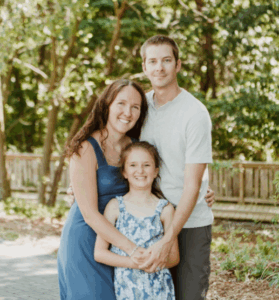

 Donate
Donate




